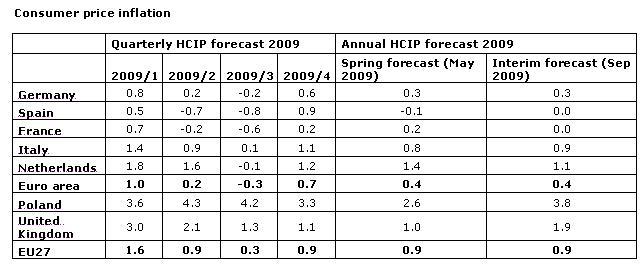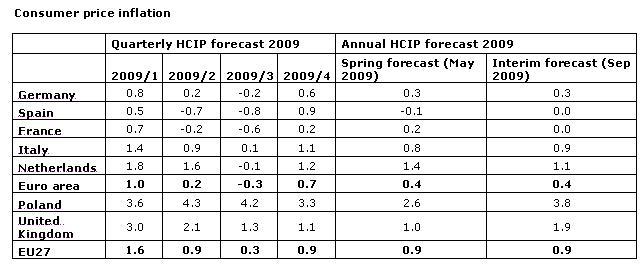The European Commission (Commission) has published its latest interim economic forecasts. The underlying message of the Commission is that signs for an economic recovery are apparent, also thanks to strong policy interventions, but the sustainability of the recovery remains to be tested. To some extent, the improving outlook for Europe reflects brighter prospects around the world. Some regions, notably emerging Asian economies, anticipate marked growth over the next six months.
Accordingly, the Commission sees signs of an imminent economic recovery, while fears of a prolonged and deep recession are fading. GDP growth is set to turn positive in the second half of the year. However, the forecast for 2009 as a whole remains unchanged as the previous estimates for 2008 and the first quarter of 2009 proved weaker. GDP is expected to fall by four percent in both the EU and the euro area this year.
Meanwhile, the rate of consumer-price inflation which declined in the first half of 2009 has been driven mostly by the base effects of past hikes in energy and food prices. Inflation seems to have reached a trough of 0.2 percent in July in the EU (-0.7 percent in the euro area). Inflation rates are projected to increase towards the end of the year as base effects reverse and commodity prices are on the rise. For the year as a whole, the outlook for consumer-price inflation remains unchanged at 0.9 percent in the EU for 2009 (and 0.4 percent in the euro area).
The coming recovery could be surprisingly strong. Whether it can be sustained remains to be seen. The Commission's next forecast, due out in November, will look ahead to the end of 2011 for all 27 EU countries.
The Commission usually publishes economic forecasts four times a year, comprehensive spring and autumn forecasts and smaller interim forecasts in February and September. The Commission's interim forecast is based on updated projections for France, Germany, Italy, the Netherlands, Poland, Spain and the UK, together accounting for some 80 percent of the EU's GDP.
The improved economic outlook reflects external conditions being increasingly favorable. Recent data for trade and industrial production, as well as business and consumer confidence, are generally encouraging. The resilient private and public consumption and advancements in the inventory cycle will also support growth in Europe.

